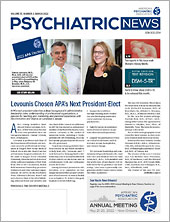APA’s Structural Racism Accountability Committee (SRAC) is investigating the status of 18 action items recommended by the Presidential Task Force on Structural Racism Throughout Psychiatry and approved by APA’s Board of Trustees to determine if they are being implemented. So said Task Force Chair Cheryl Wills, M.D.
She added that the committee is also assessing what metrics are available to evaluate the impact of the action, “assuring the items are implemented appropriately with plans for accountability and long-term sustainability.”
A detailed list of the status of the 18 action items is available in the committee’s October and December 2021 Board reports (see end of story for the link to the reports on APA’s website).
The eight-member SRAC, appointed by APA President Vivian B. Pender, M.D., is co-chaired by Mary Roessel, M.D., and Felix Torres, M.D., M.B.A. The committee is composed of Board members Elie G. Aoun, M.D., Ken Certa, M.D., Jeffrey Geller, M.D., M.P.H., Glenn A. Martin, M.D., Urooj Yazdani, M.D., and Mindy L. Young, M.D. Past APA President Altha Stewart, M.D., is a consultant to the committee.
The Task Force on Structural Racism Throughout Psychiatry was appointed in 2020 by Geller, who was then APA President. A May 2021 report to the Board of Trustees summarized the work of the task force.
By the Board’s December 2021 meeting, SRAC had met four times. In email comments to Psychiatric News, Torres said the committee classified the 18 action items into three broad categories that are central to the task force’s recommendations. These include the following:
•
Database: These actions require information from the APA member database and/or improvements to database definitions and data collection processes to enact and sustain reforms.
•
Mentorship: These actions require efforts to develop and sustain mentorship initiatives.
•
Structural: These actions require revisions to the APA Bylaws, the Operations Manual, and/or the Procedural Code of the Assembly.
“We are dedicated to seeing the work of the task force disseminated across APA, highlighting our commitment to diversity, equity, inclusion, and anti-racism,” Torres said.
In an interview with Psychiatric News, Roessel said that for many of the action items, long-term sustainability requires addressing “pipeline” issues—attracting young people from diverse communities to medicine and psychiatry.
(APA sponsors the Workforce Inclusion Pipeline Program, which is designed to increase the number of underrepresented minority medical school applicants interested in psychiatry.)
She said an especially challenging problem that calls for help from the district branches (DBs) and individual members is getting accurate and comprehensive information on the number of members who identify with minority/underrepresented (MUR) groups.
“Self-identification has been a problem,” Roessel said, adding that there may be some mistrust among members about how that information may be used.
APA Past President Altha Stewart, M.D., a consultant to SRAC, concurred. “Many individuals in what are currently called by APA ‘MUR’ groups have long been concerned about whether the organization is looking out for their best interests and about how information about individual members might be used,” she told Psychiatric News in an email. “This is especially critical for members who are African American, since that is the group that has historically led the way in getting APA to acknowledge and address its challenges dealing with an increasingly diverse membership, while seeing little return on the investment.”
She added: “As the first Black to be elected president, I know firsthand how hard it is to trust that things have changed despite efforts to improve in the areas of diversity, equity, and inclusion. I think it will take time and more conversations addressing historical and current concerns related to race and ethnicity within the profession and APA. Many APA members in the groups for whom we need more information continue to experience micro- and macro-aggressions from colleagues—including some in leadership roles. And for many of our younger members from communities of color, the pace of work to dismantle the structural systems that support racism and social injustice is inconsistent with their goals.
“As the consultant for SRAC, a past president, and a member of one of the groups that continues to speak out against the structural racism in psychiatry, I have offered my assistance to work on reducing the mistrust that continues to hinder efforts to accurately account for the demographic identification of our members and will participate in discussions needed to achieve this goal.”
Having accurate demographic information is especially crucial to fielding a diverse selection of candidates for APA’s elected offices. One of the 18 action items called for the Nominating Committee to create a database to track the pool of potential underrepresented minority nominees for national office each year. This database will include the names of individuals who had been suggested for candidacy in prior years, newly recommended individuals, and individuals who ran for national office or completed their terms as elected leaders.
In its December 2021 report to the Board, SRAC reported that the Nominating Committee had created a demographic breakdown report of the nominees in five APA elections (2017 to 2021). At press time, the committee was doing the same for 2022 nominees. SRAC and APA’s Division of Communications are planning a survey of component members to seek demographic information and a campaign to encourage APA members to self-identify on APA’s membership database via their member profile.
Torres noted that several of the task force action items refer to “URM” members (for underrepresented minority), though there is no formal definition of “URM.”
Last October, the Board approved a recommendation from SRAC to form an advisory group including APA members and staff from the Division of Diversity and Health Equity (DDHE) and the Division of Research to formally review current nomenclature, make recommendations to define “URM,” and revise current nomenclature.
Torres told Psychiatric News that DDHE has submitted to SRAC the report, “Abbreviations Utilized to Represent Membership Diversity” across medical organizations.
Next steps include the following:
•
Appointment of members to the advisory group.
•
Review by the advisory group of the current nomenclature for MUR members as codified in the Procedural Code of the Assembly, Article IV: Minority/Underrepresented Groups.
•
Development of recommendations by the advisory group to SRAC to define “underrepresented minority.”
•
Review by SRAC of the advisory group’s recommendations with a subsequent report to the Board.
In its October and December 2021 Board reports, SRAC reported on other areas of progress. Among them are Action Item 1, which calls for a list of Black APA/APAF fellows to be reported to DBs to encourage involvement in DB leadership and also for consideration as APA Assembly representatives.
SRAC reported that APA staff developed a schedule for sharing information on all APA/APAF fellows (including Black fellows) at meetings of the APA administration with the DBs, state associations, and Area councils throughout the year.
Action Item 8 calls for the development of a formal sponsorship program for minority psychiatrists by DDHE including sponsors who are members of the Board, Assembly leaders, council chairs, and other component leaders.
SRAC reported that DDHE, under the leadership of DDHE Chief Regina James, M.D., established the Advocate/Protégée Program in 2021 as part of the newly developed LEAD Institute (Leadership, Equity, And Diversity). Under this initiative, 30 APA SAMHSA Minority Fellows—the “protégées”—were paired with 30 APA “advocates” who share similar interests and can help the protégées with networking, professional growth, and career development. The invitation letter was sent out to Board members, the APA Foundation Board of Directors, and Assembly leaders. ■
More information about SRAC and its October and December 2021 Board reports with a complete list of the 18 Task Force action items is posted
here.


